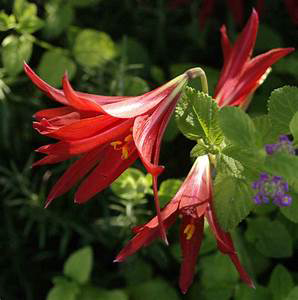MASTER GARDENERS: Oxblood Lilly brings color, elegance to fall
By Debbie Roland and
Emmy Ulmschneider
Master Gardeners
Oxblood Lilly, Rhodophiala bifida, also known as Schoolhouse Lilly, is a tropical bulb that can add a touch of color and elegance to your flower garden. The name Schoolhouse Lilly was born because the flowering period coincides with the start of school in the fall.
Whether you call it Schoolhouse or Oxblood Lily, this plant has year round appeal. The elegant, deep red flowers will surprise you when they emerge in the fall after summer dormancy. Next are the narrow green leaves which can last until winter. The flowers look like an amaryllis and are only open for two to three days. Each plant, however, will continue to produce these vibrant red flowers for about a month. The Latin name, Rhodophiala bifida, has a clue about the shape of the flower: saucer split into two parts.

Ox blood lilies grow in full sun and partial shade if they receive six to eight hours of sunlight per day. They are hardy plants that grow in a wide range of soil media and are heat and drought tolerant. Plant in the spring or early fall, sowing three inches deep with the neck up, eight inches apart. Water regularly during the first year of growth. Left alone, they will spread gracefully over time and become a remarkable focal point when they bloom. This plant thrives in hot climates but can withstand cold temperatures of up to 10 degrees Fahrenheit (-12 C).
Native to Argentina and Uruguay, this plant is cultivated for its appearance and not for its wildlife value. Bulbs are not common in many parts of the United States, but the dark red beef blood form is common in some areas of Texas. And there is a reason for this! Peter Henry Oberwetter, originally from Germany, emigrated to Texas in 1849 and traveled through the Hill Country area before settling in Austin. Renowned botanist, he collected and crossed these bulbs. Thus, the presence of Oxblood Lily correlates with the areas where it had its nursery beds. Look for his historic gravestone in Oakwood Cemetery in Austin.
Although Oxblood Lily is not usually available at a nursery, gardeners would recognize it as a plant to pass on. Masterpieces are plants that have survived in gardens for decades, being loved and passed down from generation to generation. Over the decades, people have recognized the special characteristics of these heirloom plants: hardiness, special beauty or fragrance, valuing them as one would for a special family recipe. And just like a legacy connects you to the past, plants to pass on help you remember the people, places, and events that are a part of who you are.
So if you want a plant that can connect you to Texas history and your own history, find a garden with oxblood lilies, ask for a bulb, and see if you too can be a part of that chain. transmission.
If you have any questions, please call the AgriLife office in Odessa at 498-4071 or in Midland at 686-4700 for more gardening information. Additional information is available at https://aggie-horticulture.tamu.edu and westtexasgardening.org.

